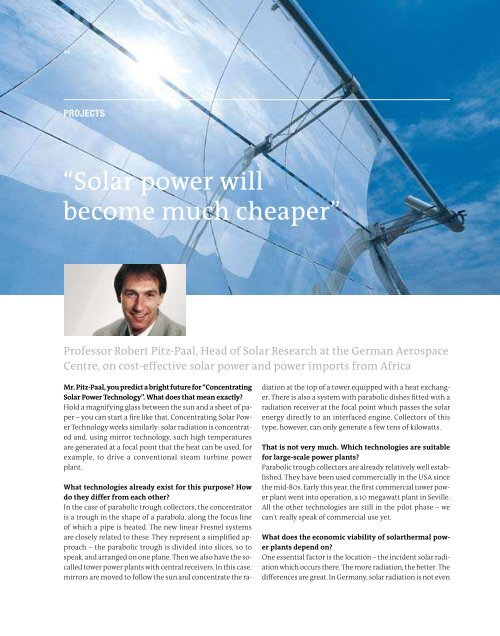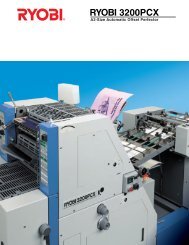THE ECHO - Ferrostaal
THE ECHO - Ferrostaal
THE ECHO - Ferrostaal
Create successful ePaper yourself
Turn your PDF publications into a flip-book with our unique Google optimized e-Paper software.
44<br />
ProjECtS<br />
“Solar power will<br />
become much cheaper”<br />
Professor Robert Pitz-Paal, Head of Solar Research at the German Aerospace<br />
Centre, on cost-effective solar power and power imports from Africa<br />
Mr. Pitz-Paal, you predict a bright future for “Concentrating<br />
Solar Power Technology”. What does that mean exactly?<br />
Hold a magnifying glass between the sun and a sheet of paper<br />
– you can start a fire like that. Concentrating Solar Power<br />
Technology works similarly: solar radiation is concentrated<br />
and, using mirror technology, such high temperatures<br />
are generated at a focal point that the heat can be used, for<br />
example, to drive a conventional steam turbine power<br />
plant.<br />
What technologies already exist for this purpose? How<br />
do they differ from each other?<br />
In the case of parabolic trough collectors, the concentrator<br />
is a trough in the shape of a parabola, along the focus line<br />
of which a pipe is heated. The new linear Fresnel systems<br />
are closely related to these. They represent a simplified approach<br />
– the parabolic trough is divided into slices, so to<br />
speak, and arranged on one plane. Then we also have the socalled<br />
tower power plants with central receivers. In this case,<br />
mirrors are moved to follow the sun and concentrate the ra-<br />
diation at the top of a tower equipped with a heat exchanger.<br />
There is also a system with parabolic dishes fitted with a<br />
radiation receiver at the focal point which passes the solar<br />
energy directly to an interfaced engine. Collectors of this<br />
type, however, can only generate a few tens of kilowatts.<br />
That is not very much. Which technologies are suitable<br />
for large-scale power plants?<br />
Parabolic trough collectors are already relatively well established.<br />
They have been used commercially in the USA since<br />
the mid-80s. Early this year, the first commercial tower power<br />
plant went into operation, a 10 megawatt plant in Seville.<br />
All the other technologies are still in the pilot phase – we<br />
can’t really speak of commercial use yet.<br />
What does the economic viability of solarthermal power<br />
plants depend on?<br />
One essential factor is the location – the incident solar radiation<br />
which occurs there. The more radiation, the better. The<br />
differences are great. In Germany, solar radiation is not even<br />
<strong>THE</strong> <strong>ECHO</strong> August 2007<br />
half as high as in southern Spain. In the Californian desert<br />
it is another thirty or forty per cent higher - three times as<br />
high as in Germany in other words. That makes power generation<br />
much cheaper. Another important factor is the size<br />
of the solar power plant. The larger the plant, the more viable.<br />
And then, of course, the technology is also crucial - it<br />
has to be as inexpensive as possible while nevertheless being<br />
efficient. If higher temperatures can be achieved at lower<br />
cost, the viability can be increased. That is exactly the aim<br />
of Fresnel technology.<br />
How realistic are solar power plants in Africa? The sunshine<br />
is very reliable there.<br />
There have already been invitations to tender in various African<br />
states. In Algeria, construction of the first power plant<br />
is just starting. Morocco and Egypt will probably conclude<br />
contracts this year. The potential in North Africa is enormous.<br />
There are really large open spaces there, with very<br />
high radiation combined with a rapidly growing demand<br />
for energy. Particularly in the case of Africa, it is important<br />
that solar technology be developed quickly and for it to<br />
become competitive. This is due to the fact that in Africa,<br />
unlike here, there are very few subsidies for regenerative<br />
energy.<br />
If we bundle solar power generation for Europe in that<br />
region, are we not making ourselves as dependent in future<br />
on the sunny countries of Africa as we now are on<br />
the oil states?<br />
No. The DLR has carried out a series of studies. The scenarios<br />
assume that, by 2050, about 15 per cent of our energy requirements<br />
can be covered by solar imports from Africa and that<br />
the remainder will largely be directly generated in Europe using<br />
our own renewable resources. Today we are still 60 per<br />
cent dependent on imports.<br />
But renewable resources are still relatively expensive to<br />
produce, so there is little demand. According to dLR forecasts,<br />
production costs for solarthermal power plants will<br />
be halved by the year 2020. How will this be achieved?<br />
The Scientific Advisory Board to the German Federal Government<br />
estimates that, by the end of the century, energy requirements<br />
will mainly be met by solarthermal power plants.<br />
By the mass production of components, by the construction<br />
of very large plants and by the achievement of better<br />
efficiency by means of higher temperatures – for example<br />
by direct steam generation using Fresnel technology – and<br />
by the integration of large thermal energy storage units. All<br />
of these factors are already feasible. But until we have reached<br />
that stage, we will be dependent on subsidised markets.<br />
do firms who invest now have to accept that they will<br />
make losses in the initial phase?<br />
I think not because, fortunately, there are feed-in tariffs and<br />
other incentives. The market introduction of solar technology<br />
has political support, the additional costs for renew-<br />
able energies in Spain and Germany, for example, are borne<br />
by all power consumers – an essential mechanism which<br />
costs the individual citizen very little but which will benefit<br />
national economies in the long term, as prices for fossil<br />
fuels are rising.<br />
Example of the global energy<br />
mix in 2100<br />
Primary energy use (exajoules per year)<br />
1600<br />
1400<br />
1200<br />
1000<br />
800<br />
600<br />
400<br />
200<br />
0<br />
Geothermics<br />
Other renewables<br />
Solar collectors<br />
Solarthermal power plants<br />
and photovoltaic units<br />
Wind<br />
Biomass (modern)<br />
Biomass (traditional)<br />
Hydropower<br />
Gas<br />
Coal<br />
(Source: Wissenschaftlicher Beirat der Bundesregierung für globale Umweltveränderungen<br />
– Scientific Advisory Board to the German Federal Government on Global Environmental<br />
Change – 2003)<br />
Oil<br />
45
















